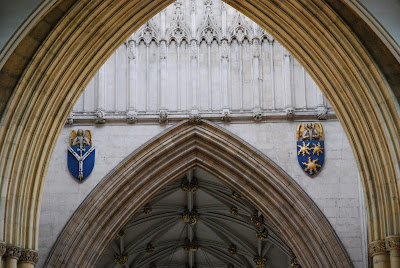Today's conundrum: How are the attributed arms of St. Wilfrid blazoned? And can you get to that blazon from five (well, really four, because two of them are the same) emblazons of those arms?
Because, frankly, those varying emblazons are all (except for the two matching ones) significantly different.
First, the three found wandering the streets of York, England; the one, and then the two matching ones:
Then, this one, found on the exterior of York Minster:
And this one (on the right) from the interior the Minster:
So, knowing that these different depictions are all supposedly those of the attributed arms of St. Wilfrid, how would you blazon his arms?
Take and minute and think about it.
Feel free to click on any of the images above to go to a larger photo to look at them more closely.
How are these arms blazoned?
Just from looking at them, I would blazon the first one as: Azure three mullets of six points argent.
The next two (the matching ones), and assuming the same tinctures, I would blazon as: Azure three mullets of eight points argent.
The third, from the exterior of York Minster, and the fourth, from the interior, are blazoned by Hugh Murray in Heraldry and the Buildings of York, and by Y.E. Weir in A Guide to the Heraldry of York Minster, as Azure three estoiles or.
The difficulties, in my own mind, are:
1. Mullets (of however many points) are not the same heraldically as mullets;
2. Estoiles are generally of six rays, while those here pretty clearly have seven; and
3. Estoiles do not have, as they seem to in the last image, circular centers.
Going out onto the internet and looking up other images of the attributed arms of St. Wilfrid, the majority tend to follow the pattern of Azure three estoiles of seven rays or.
But I have to wonder, should they really be suns? (Yes, I am well aware that suns are generally depicted with alternating straight and wavy rays. Still, that seems a little more likely than seven-rayed estoiles. But what do I know?)
Anyway, it's a bit of a puzzle, one that leaves us all a little something to think about.
Enjoy!


















No comments:
Post a Comment